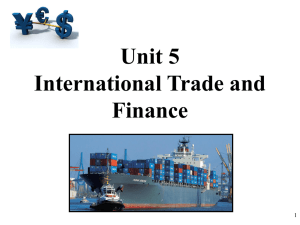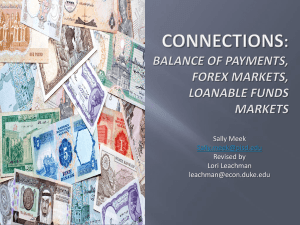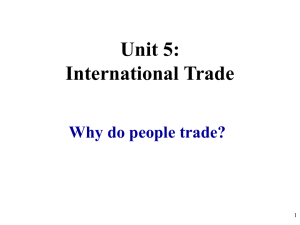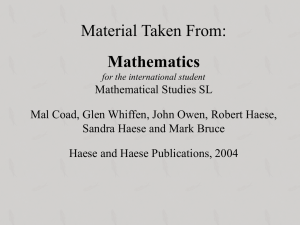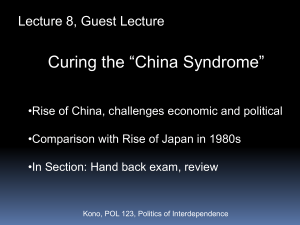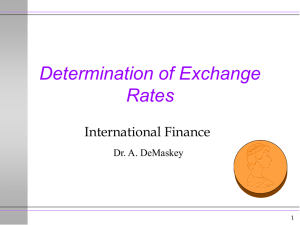AP Macro 5-3 Foreign Exchange
advertisement
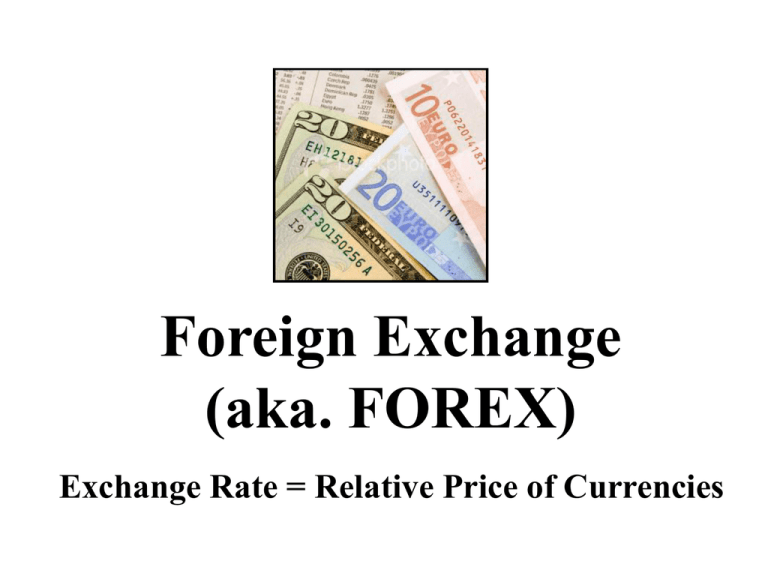
Foreign Exchange (aka. FOREX) Exchange Rate = Relative Price of Currencies Exports and Imports • • • • US sells cars to Mexico Mexico buys tractors from Canada Canada sells syrup t the U.S. Japan buys Fireworks from Mexico A. For all these transactions, there are different national currencies. B. Each country must be paid in their own currency C. The buyer (importer) must exchange their currency for that of the sellers (exporter). The turnover in FOREX markets is almost $4 trillion (USD) a day Currency Codes USD = US Dollar EUR = Euro JPY = Japanese Yen GBP = British Pound CHF = Swiss Franc CAD = Canadian Dollar AUD = Australian Dollar NZD = New Zealand Dollar Exchange Rates A. In the FOREX market we only look at two countries/currencies at a time • Ex: US Dollars and British Pounds B. We examine the price of one currency in terms of the other currency. Ex:$2 = £1 C. The Exchange Rate depends on which currency you are converting. D. The price of one US Dollar in terms of Pounds is • 1 Dollar = £1/$2 = £.5 E. The price of one Pound in terms of Dollars is • 1 Pound = $2/£1 = $2 What happens if you need more dollars to buy one pound (the price of a pound increases)? Ex: From $2=£1 to $5=£1 • The U.S. Dollar DEPRECIATES relative to the Pound. Depreciation 1. The loss of value of a country's currency with respect to a foreign currency 2. More units of dollars are needed to buy a single unit of the other currency. 3. The dollar is said to be “Weaker” What happens if you need less dollar to buy one pound (the price of a pound decreases)? Ex: From $2=£1 to $1=£4 •The U.S. Dollar APPRECIATES relative to the Pound. Appreciation 1. 2. 3. The increase of value of a country's currency with respect to a foreign currency Less units of dollars are needed to buy a single unit of the other currency. The dollar is said to be “Stronger” Exchange Rates FOREX Video Interlude S&D for the US Dollars Price of US Dollars Pound£ Dollar$ Equilibrium: $1 = £1 Supply by Americans 2£/1$ 1£/1$ US Dollar appreciates US Dollar depreciates 1£/4$ Demand by British Quantity of US Dollars Q FOREX Supply and Demand Simplified 1. Imagine a huge table with all the different currencies from every country 2. This is the Foreign Exchange Market! 3. Just like at a product market, you can’t take things without paying. 4. If you demand one currency, you must supply your currency. Ex: If Canadians want Russian Rubles. The demand for Rubles in the FOREX market will increase and the supply of Canadian Dollars will increase. FOREX Shifters Let’s use the example of the US Dollar and the British Pound 1. Changes in TastesEx: British tourists flock to the U.S… Demand for U.S. dollars increases (shifts right) Supply of British pounds increases (shifts right) Pound-depreciates Dollar-appreciates 2. Changes in Relative Incomes (Resulting in more imports)Ex: US growth increase US incomes…. U.S. buys more imports… U.S. Demand for pounds increases Supply of U.S. dollars increases Pound- appreciates Dollar- depreciates 3. Changes in Relative Price Level (Resulting in more imports)- • Ex: US prices increase relative to Britain…. a. U.S. demand for cheaper imports increases… b. U.S. demand for pounds increases c. Supply of U.S. dollars increases d. Pound- appreciates e. Dollar- depreciates 4. Changes in relative Interest Rates• Ex: US has a higher interest rate than Britain. a. British people want to invest in US b. Capital Flow increases towards the US c. British demand for U.S. dollars increases… d. British supply more pounds e. Pound- depreciates f. Dollar- appreciates Practice For each of the following examples, identify what will happen to the value of US Dollars and Japanese Yen. 1. American tourists increase visits to Japan. 2. The US government significantly decreases personal income tax. 3. Inflation in Japan rises significantly faster than in the US. 4. Japan has a large budget deficit that increases Japanese interest rates. 5. Japan places high tariffs on all US imports. 6. The US suffers a larger recession. 7. The US Federal Reserve sells bonds at high interest rates. How do these scenarios affect exports and imports? Practice For each of the following examples, identify what will happen to the value of US Dollars and Japanese Yen. 1. 2. 3. 4. 5. USD depreciates and Yen appreciates USD depreciates and Yen appreciates USD appreciates and Yen depreciates USD depreciates and Yen appreciates USD depreciates (Demand Falls) and Yen appreciates (Supply Falls) 6. USD appreciates (Supply Falls) and Yen depreciates (Demand Falls) 7. USD appreciates and Yen depreciates Scenarios 1, 2, and 4 will increase US exports because US products are now relatively “cheaper”
